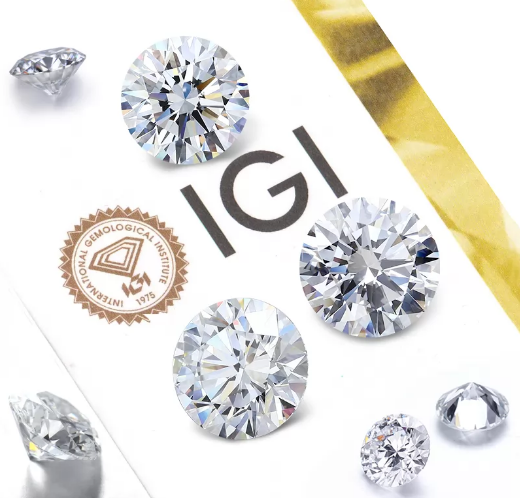Diamond gemstones have traditionally symbolized value, status, and rarity. While these gems are often associated with expressions of love, anniversaries, and engagements, others proudly adorn them as fashionable symbols of their success.
In the past, diamonds were exclusively sourced from natural mines, but today, advancements in technology allow for the cultivation of diamonds in specialized laboratory settings. The question arises: how do lab-grown diamonds compare in terms of retaining their value over time? Here's what you need to understand.

FACTORS INFLUENCING DIAMOND VALUE
Throughout history, diamond gemstones have served as tangible symbols of prestige and wealth. However, like any other commodity, the monetary worth of diamonds has experienced fluctuations over the years, influenced by various market factors, including supply and demand dynamics.
Similar to precious metals such as gold, silver, and platinum, the value of diamonds is subject to changes based on their status as a commodity. For instance, the discovery of new diamond mines can lead to a natural decline in diamond prices due to an increased supply. Conversely, the laws of supply and demand dictate that diamond values rise when the demand for these precious stones intensifies.
Diamonds are often deemed wise investments due to their ability to maintain a competitive market value, either remaining stable or appreciating over time. This is primarily attributed to the limited availability of natural diamonds on Earth. Therefore, purchasing a natural diamond at a fair price and ensuring its proper care typically results in a gradual increase in overall value over time.
In contrast, the predictability of lab-grown diamonds is less assured. While physically and optically identical to natural diamonds, lab-grown counterparts lack a finite supply. As a result, they do not offer the same type of resale value as natural diamonds, making them a less reliable investment option.
ARE LAB-GROWN DIAMONDS A GOOD INVESTMENT?
As mentioned earlier, scarcity plays a pivotal role in determining the value of a product. Natural diamonds, being relatively rare, hold higher value compared to their lab-grown counterparts, which are not constrained by scarcity. Consequently, the resale value of lab-grown diamonds tends to be lower when compared to gemstones extracted from the Earth.
However, lab-grown diamonds present several compelling advantages that resonate with contemporary buyers. Beyond their striking resemblance to natural diamonds, these synthetic gems are crafted using responsibly sourced materials in an environmentally and socially responsible manner.
In contrast, natural diamonds are often associated with human rights issues and ecological concerns. Given that lab diamonds are produced in controlled environments, ethical concerns are significantly mitigated. Additionally, lab-grown diamonds typically cost approximately 30% less than their natural counterparts of similar quality and size.
For many individuals, these factors are substantial enough to outweigh any reservations about the limited resale value of lab-grown diamond gemstones. The combination of ethical considerations and cost-effectiveness makes lab-grown diamonds an appealing choice for those seeking a socially responsible and budget-friendly alternative to traditional natural diamonds.
ARE LAB-GROWN DIAMONDS VALUABLE?
Natural diamonds undergo a remarkable transformation over billions of years, forming deep within the Earth under intense pressure and high temperatures. In stark contrast, lab-grown diamonds are created swiftly through specialized technology. Despite the divergent origins, both types of gemstones are identical down to the smallest molecule, with the sole distinction being the microscopic inscriptions found on lab-grown diamonds.
While these gems mirror mined diamonds in every aspect, the crucial difference lies in their availability. Unlike natural diamonds with a limited supply, lab-grown diamonds lack this constraint, significantly impacting their value. This factor contributes to the observed decline in the resale value of lab-created diamonds in recent years.
Similar to other valuable commodities, natural diamonds tend to appreciate in value over time, aligning with inflationary trends. A diamond acquired in 1980 holds significantly higher worth in today's market. The attribution of this value escalation, whether rooted in the stone's rarity or the broader impact of inflation, hinges on various factors. These include the gem's distinctiveness, the prevailing popularity of its shape, its overall quality, color, and other relevant considerations.
Unlike natural diamonds mined from the earth, lab diamonds won’t usually gain value. In fact, in recent years, their value hasn’t kept up with inflation, mostly due to the increased availability of lab-grown gemstones. So, to put it simply: a lab-grown diamond isn’t going to bring much, if any, return on investment. Conversely, the appreciation in value for natural diamonds often stems from their relative scarcity and the ebb and flow of market demand. Nevertheless, many individuals find that the appeal of a stunning, cost-effective lab-grown diamond, paired with an artistically crafted ring, offsets considerations related to value fluctuations.
PRICE OF LAB-GROWN DIAMONDS
Over the past few years, lab-grown diamonds have experienced a surge in popularity, accompanied by a notable decline in prices.
Now, you might wonder, doesn't heightened demand typically drive prices upward? While this is generally true, the unique aspect of lab-grown diamonds lies in the industry's response to increased demand. Suppliers have proactively boosted production, resulting in a reduction in the prices of lab-grown diamonds. This trend has enabled contemporary consumers to acquire exquisite diamond jewelry at more affordable prices.
However, it's crucial to bear in mind that the value of jewelry encompasses more than just the diamond. The precious metal content and the distinctive design of the piece also play significant roles in determining overall pricing.
ARE LAB-CREATED DIAMONDS WORTH ANYTHING WHEN RESOLD?
Despite a decline in resale value, it's crucial not to misinterpret this trend as an indication of inferior quality in lab-grown diamonds. The lower cost of lab diamonds, up to 30% less than their natural counterparts, is not reflective of reduced quality. Quite the opposite, as lab diamonds are more affordable due to their abundance and a shorter supply chain.
While it's true that lab-grown diamonds may not command as high a resale value as natural diamonds, it's essential to consider the primary purpose of acquiring a stunning diamond piece. Ultimately, the intention is often to own an elegant expression of personal style or a meaningful token of love destined to become a cherished heirloom passed down through generations.
THE REAL VALUE OF YOUR DIAMOND
What transforms a natural or lab diamond into an investment-grade gemstone? The answer lies in its color, cut, clarity, and carat weight. The higher a diamond ranks in these crucial categories, the greater its current and future monetary value. Similar to the depreciation observed in the value of a vehicle post-purchase, a diamond's worth can decline rapidly. However, investing in a high-quality jewelry piece and maintaining its care can lead to a relatively consistent value, potentially even appreciating over time. Ultimately, the genuine value of a diamond extends beyond its monetary worth; it encapsulates the representation of an enduring love story.



 Lab Grown Emerald
Lab Grown Emerald


